← Go back
Proposal
Personal Information
Name: Gauravjeet Singh
Email Address: gaurav.ishwerdas@gmail.com
IRC Username: gjeet
Brief Background Info
I study in 3rd year B.Tech (Computer Science and Engineering) at Guru Nanak Dev Engineering College, Ludhiana (India). I was welcomed in this community in late 2012 via Google Code In (GCI). I was a GCI 2012 student and then acted as a GCI mentor of BRL-CAD for next two consecutive years (2013 & 2014).
I have been interested in 3D graphics from a long time. In early 2013, after finishing up with GCI as a student, I started looking for opportunities to work with BRL-CAD. And I ended up taking a very small part of BRL-CAD functionality on the web, using a simple shell script and CGI. Here’s the Github repo of that app: https://github.com/GreatDevelopers/wBRLCAD/tree/master/general/tableModel
Later that same year(2013), I came to know about a GSoC project called Online Geometry Viewer. I have been an active listener about OGV discussions since then.
Also, I have been contributing to various Meteor projects in the past few months. These include
- Lord Byron: A real-time text editor that checks for grammar using Natural Language Processing.
- Blocks: Application for making presentations and static websites
My experience in meteor and interest in 3D graphics makes OGV a perfect project for me.
Project Information
Brief Summary
OGV has the ambition to become something of an Instagram for 3D models. It includes features like profiles, likes, comments, followers. But the code is a lot buggy and unstable.
What has been done As previously stated Online Geometry Viewer started as a GSoC project in 2013 by a student named Harmanpreet Singh to show BRL-CAD modeling capabilities on the web. It was initially a vanilla PHP + three-js project. This project was continued by Inderpreet Singh in 2014 and was converted to Meteor from vanilla PHP in order to get a robust backend. Next year in 2015 two Students Deepak Sharma and Shubham Chauhan continued the meteor project.
What I will do One of the major motives of my GSoC would be to improve the existing code. To complete the things that are almost complete. Also, the new features I am adding aren’t completely new, they are an extension of some existing feature of OGV. By the end of GSoC, I want OGV to be production ready and available to use for a wider majority of people.
I am mostly concentrating on the efficiency and control over the model viewer. For now, we can only view the complete model. We have no control over what parts of a model to show/hide. This includes giving different color/material separately to different parts of a model instead of the complete model. There are much more such things that I would accomplish during my GSoC tenure. Things I will do in GSoC are listed as following:
Things that I’ll improve:
- Search (for models, users and even parts inside model)
- Database schema (Adding schema to the collections)
- Increasing speed and efficiency in handling Obj files (merging multiple Obj files and removing duplicates)
- Overall User Experience and User Interface
- Removing redundancy and unused code
Things that I’ll add:
- Show/hide parts of model (also color them separately)
- Adding push notifications for like, comment, share
- Easy Deployment procedure
- Adding view restrictions on uploaded models
- Enabling users to create Groups/lists of followers
Detailed Project Description
Code Cleanup
- Github branches and PR’s: There are a lot of branches and PR’s pending, my task would be to merge all the code and get the desired stable code in the master branch.
- Current Code: Changes in the code includes adapting to more appropriate variable names, removing redundant code.
For example, there exists redundant code in file OGV/client/views/model_viewer.js at line no 220. The package ishwerdas:ogv-threejs is not updated since it is created by Inderpreet Singh in 2014. There are many such instances in the code that needs to be fixed.
Robust and secure database by using Schema
We are using MongoDB in OGV. It is a schema-less database. But however, it is generally a good practice to define a schema that validates the content of the collection. If we don’t use schema, there comes a high chance of adding wrong values in the database. That’s the reason meteor officially supports and recommends using schema. http://guide.meteor.com/collections.html#schemas To add schema to meteor collections, we may use package
aldeed:simple-schema
For instance, we have a collection in OGV called “Ogvsettings”.
settings.schema = new simpleSchema({gobjPath: {type: string} });
If we apply the above schema to collection Ogvsettings, it will make sure we get a string value in the “gobjPath” field of the collection. Thus, making our application more robust and secure.
Efficiency in handling Obj files
OGV is a bit slow for now. It can’t handle big models, one of the main reasons is the number of HTTP requests for each obj file. Thus, OGV can be boosted by doing following things:
- Removing duplicates: When a .g file is converted into obj, each converted obj is copied to another location. Thus, there exists a duplicate file for each obj file. Thus occupying unnecessary storage to the server. Obj files are created at OGV/.meteor/local/cfs/files/modelFiles during conversion, which aren’t required while viewing the model. Thus, they occupy extra space. I will write the code that removes these files after a certain amount of time automatically so that there is no wastage of server space.
- Merging all OBJ files into one: On model rendering page, multiple requests are made(~300 for complex objects) thus slowing down OGV. Therefore merging obj files will reduce HTTP requests by a big number.

- Group/Ungroup merged Obj file: User should get an option to group/ungroup the merged obj file. As I will load only one obj file for the sake of speed but I don’t want the user to lose control over the model. Therefore, the user will ungroup to load each part of model separately. More on this is explained in below section Control over the model.
Control over the model
- Show/hide parts of model: While working on a 3D model, the user always finds a need to look into a specific part of a model instead of the complete model. Because of this, I am adding an option to show/hide parts of a model. Once the model is ungrouped, we can show/hide any part of a model. Also we can change the names of the objects, by double clicking on the obj name in list. Instead of obj file names we can define our own names for each part of object. These names will then be seen when hovered with mouse over the part of model
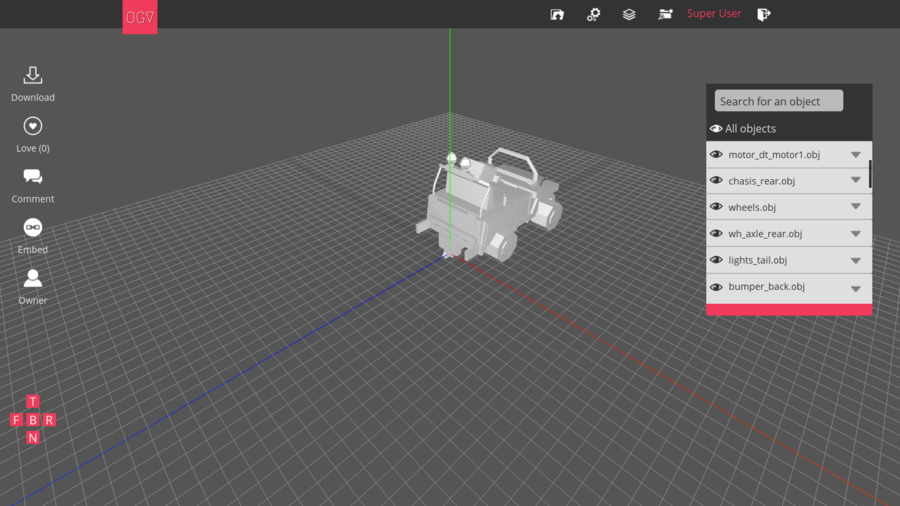
- Coloring parts of model: Once the model is ungrouped, we get a set of different parts that can be colored in a separate color or a material texture.
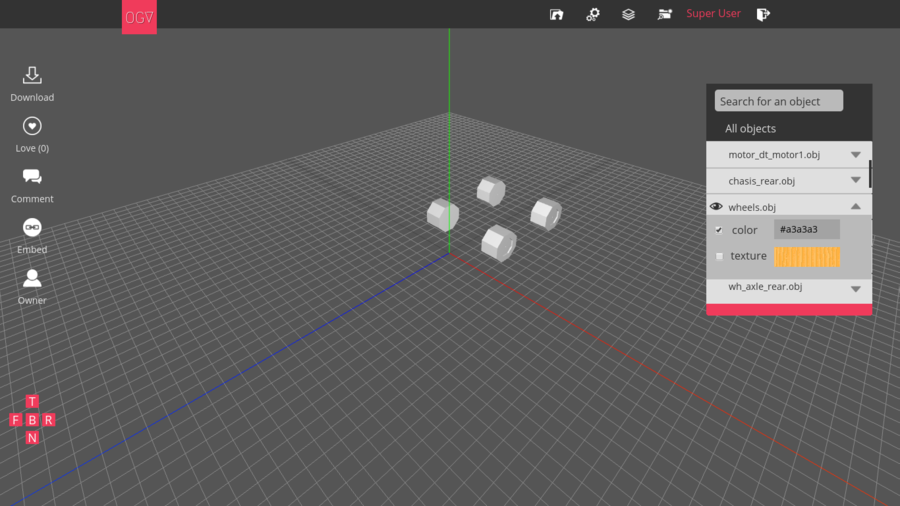
Search
- Searching parts of Model: Complex models have a large number of parts, so it isn’t feasible to go through the list manually to find a specific part in order to perform an operation on it. Thus there comes the need of searching the part of the model.
- Searching users and models: OGV already has this search. But it isn’t much functional. We can’t go to the desired model from the search results. Also, the existing search uses simple string comparison instead of any search algorithm. I would like to use phonetic search and auto-complete search algorithm for an enhanced search experience. Following meteor package can help us achieve autocorrect, phonetic search experience.
art1sec8:fuse
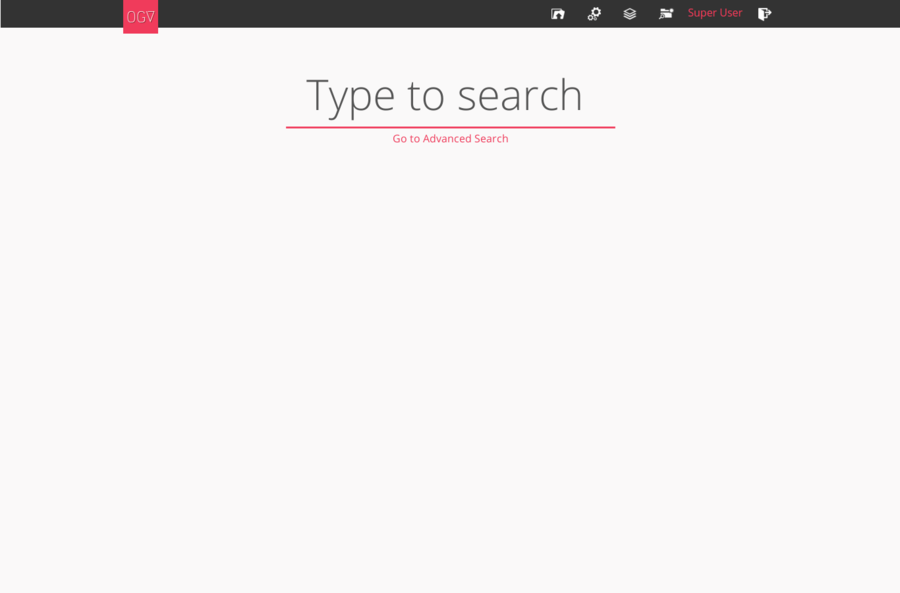
When searched, it shows both users and models, at the same time.
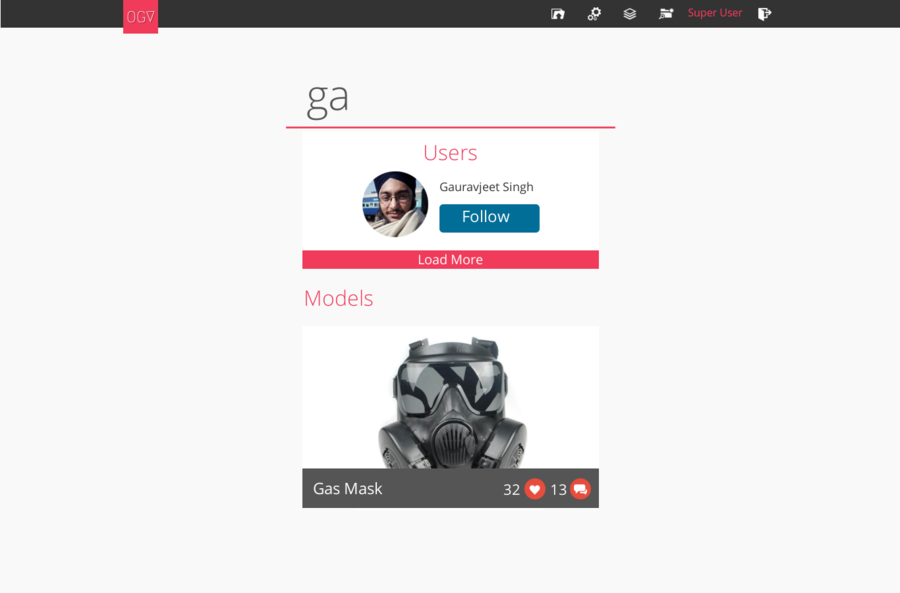
- Advanced Search: With this we can search for models using certain filters. Filters include filter by the owner of the model, category of a model
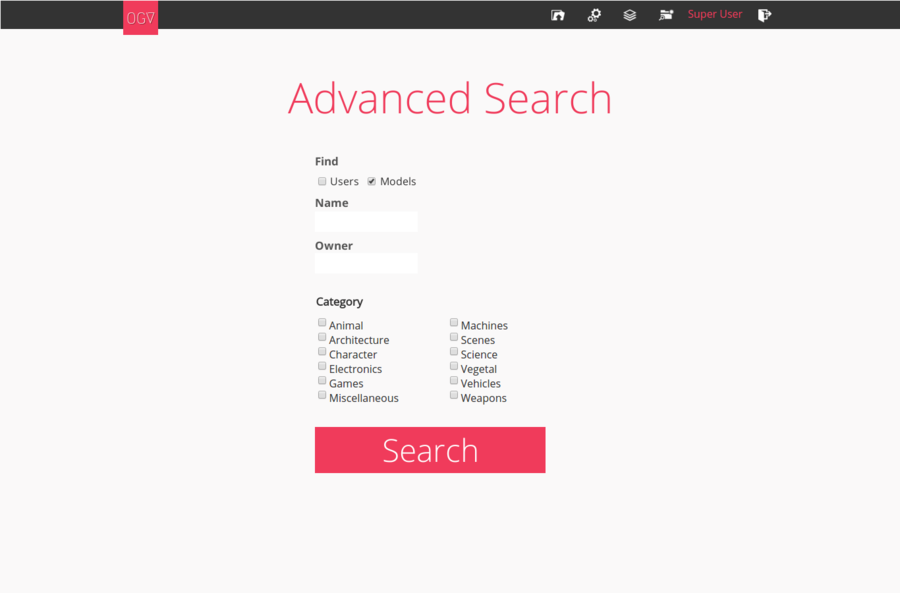
Notifications
- Better notification UI: The current notification style cover the entire top bar, and hides the menu, thus the user can not go anywhere until he/she closes the notification. In OGV, there is a mixture of meteor sAlert notifications and simple javascript Alert. Simple javascript alerts can’t be styled much, So I would transform all the alerts to meteor sAlert. Sometimes when we follow another user, we get two sAlerts. This inconsistent behaviour of notifications needs to be fixed.
- Adding notification panel: A separate panel that will record all the notifications and can show the history whenever a user needs.
- Push notifications: Every time a user likes/comments/shares your uploaded model, you will get a push notification in the notification panel and also in the mail. Notification in the mail is configurable. You can switch it off if you don’t want it.

Customized Access to models
- Private models: Only user itself can see the privately uploaded models. These doesn’t appear in the news feed.
- Groups/lists: Allowing the user to classify the followers into groups or lists. And then share the model only with the chosen groups/lists.
- Only followers: Only users who follow can see the uploaded model
- Public models: Anyone can see the uploaded model.
UI/UX improvements in model
- Progress bar for uploading: When user uploads a model, the progress bar will come as shown in figure below. CollectionFS comes with a template for progress bar
``
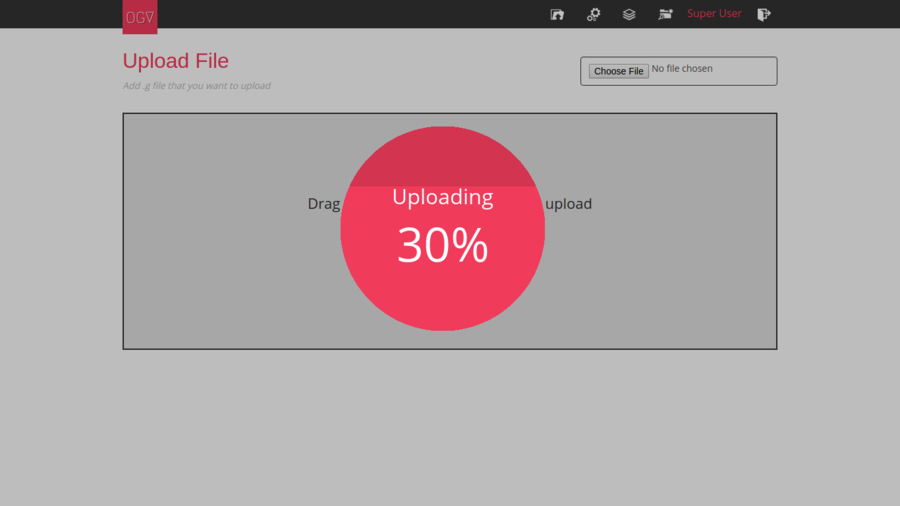
- Progress bar for conversion: In current OGV code, the conversion percentage is already being calculated in file OGV/server/cfs_uploader.js (variable name: ConvertPercentage). I am going to use that percentage variable with a javascript function, that animates the button.

- Thumbnail Generation : For now, we have to manually upload an image file to be used as a thumbnail of the model. Automatic thumbnail generation will snapshot the rendered view of a model, and use that image as a thumbnail.
The suggested technology for this is phantomJs. But I was successful in creating a screenshot with simple javascript from the console. Also doing it this way seems a right approach to me.
window.open( renderer.domElement.toDataURL( 'image/png' ), 'screenshot' );
This simple javascript line when executed from the console, will open the screenshot in a new tab.
- ’ Improvements in social elements’: Social elements like love and comment needs some UI refreshment. Also, another social element of sharing someone else’s model on your profile is going to be a part of this task.
- Improved embedded view: Right now the embedded view is cluttered, I have already fixed this with PR: https://github.com/BRL-CAD/OGV-meteor/pull/34 But now it only shows the model, and social elements like count of total love and comment are hidden. The improved view will show the social elements on mouse hover in embedded view.
Admin Panel
- Getting rid of hard coded superuser: Now when we install OGV, a super user admin@example.com is already in a database. The username and password of this user are written into the code itself. (in file OGV/server/accounts.js) Instead of this hard coded user, a more righteous approach would be to enable the admin to create a super user when a fresh install of OGV is done. The way we do during a Wordpress installation.
- Improved Admin panel: Currently in OGV, the admin panel contain settings like SMTP URL, mged path, g-obj path. There aren’t any settings related to other users and OGV. A super user should have settings to
- Enable/Disable private model uploads
- Enable/Disable user registrations
- View statistics of total model uploads by each user
- Enabling guest users to upload the model without signing up.
Deployment
- Deploying on a freeBSD system
- Establishing a mechanism that automatically updates the code on server when a new commit is pushed in master branch (gruntjs)
- During the course of GSoC, every friday would be a deployment Friday(not of the master branch, but of the gsoc branch, so that it can be regularly tested by other members of the community).
Milestones
- Community Bonding Period
- Discuss on blaze to react conversions
- Making Repository ready for deployment
- WEEK 1 (23rd May)
Code Cleanup (Removing redundant/unused code) (23rd - 29th May)
- WEEK 2 (30th May)
Deployment (Deploying master branch on freeBSD and also making scripts for automatic deployment)
- WEEK 3 (6th June)
Robust database using aldeed:schema
- WEEK 4 (13th June)
- Improving notifications
- Push notifications
- notifications panel
- adding share functionality
- WEEK 5 (20th June)
- Improving user and model search using art1sec8:fuse
- Improving UI for social elements
- WEEK 6 (27th June)
- Thumbnail Generation
- Code cleanup for mid term evaluation
MID-TERM EVALUATION
- WEEK 7 (4th July)
- Merging Obj files using threejs geometry and objExporter
- Removing duplicate obj files.
- WEEK 8 (11th July)
- Search inside models
- show/hide parts
- WEEK 9 (18th July)
- Giving different color/material(image) to different parts
- Progress bars (upload and conversion)
- WEEK 10 (25th July)
- Creating groups/lists of followers
- Restricting access to model viewing (public/private models)
- WEEK 11 (1st August)
- admin panel
- WEEK 12 (8th Aug)
- Minor UI/UX improvements
- WEEK 13 (15th Aug)
- Code Cleanup
- Testing
- Final Deployment
FINAL EVALUATION
My Preparation
- I have been studying about the meteor, specifically for OGV.
- I have also gained some experience mged commands and using BRL-CAD.
- I have read and understand how g to obj converts.
- I have already sent a PRs regarding embedded view of models and other things in OGV.
- I have spent great deal of time in reading the roadmaps and inner workings of meteor, so that we code with future in our mind.
Why BRL-CAD?
- I have been a part of this community for about 4 years now.
- I feel like home at this community
- When it came to GSoC I really didn’t have to choose, I knew I would go with BRL-CAD.
Why Me?
- I have a rich community experience with BRL-CAD.
- I have sufficient meteor experience. I have been contributing to a number of meteor projects.
- I am following OGV, from its first iteration in 2013 till now.
- I have been a participant of GCI 2012 and mentor in GCI 2013, 2014. And I tried to be helpful where I can like in BRL-CAD website.
- I have interested in bringing BRL-CAD to web since 2013. Link to repository: https://github.com/GreatDevelopers/wBRLCAD/tree/master/general/tableModel